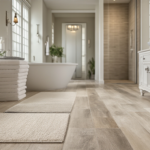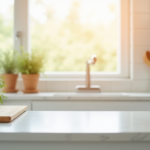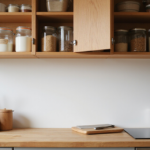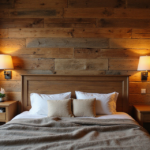The industrial revolution taught us that beauty emerges from the marriage of function and form – a principle that resonates deeply in today’s farmhouse kitchen design. While my expertise typically gravitates toward exposed steel beams and concrete countertops, I’ve discovered that the farmhouse aesthetic shares our commitment to authentic materials and purposeful design. The backsplash, in particular, serves as the perfect canvas where raw functionality meets refined character.
In my years designing urban lofts and warehouse conversions, I’ve learned that the most compelling spaces tell stories through their materials. A farmhouse kitchen backsplash operates on the same principle – it’s not merely protection against splashes, but a narrative element that speaks to craftsmanship, heritage, and the honest beauty of well-chosen materials. Whether you’re drawn to the industrial edge of exposed brick, the clean geometry of subway tile, or the organic imperfection of reclaimed wood, your backsplash choice defines the space’s personality.
The challenge lies in navigating the vast landscape of options while maintaining design integrity. How do you balance the rustic charm of traditional farmhouse elements with the sophisticated functionality that modern living demands? Which materials offer both the aesthetic impact and the durability required for a hardworking kitchen environment? These are the questions that separate amateur decoration from professional design.
This comprehensive guide presents 20 essential farmhouse kitchen backsplash ideas, each examined through the lens of both aesthetic impact and practical performance. From material selection and pattern exploration to installation considerations and maintenance requirements, we’ll build a foundation for making confident decisions that honor both your design vision and your daily needs.
1. Master the Foundation: Understanding Farmhouse Backsplash Styles
The architectural integrity of any farmhouse kitchen backsplash begins with understanding the distinct sub-styles within the broader farmhouse movement. Like the industrial spaces I typically design, each variation demands specific material choices and design approaches that respect its fundamental character. Modern Farmhouse leans toward clean lines and simplified forms, while Rustic Farmhouse embraces the weathered patina of age and use.
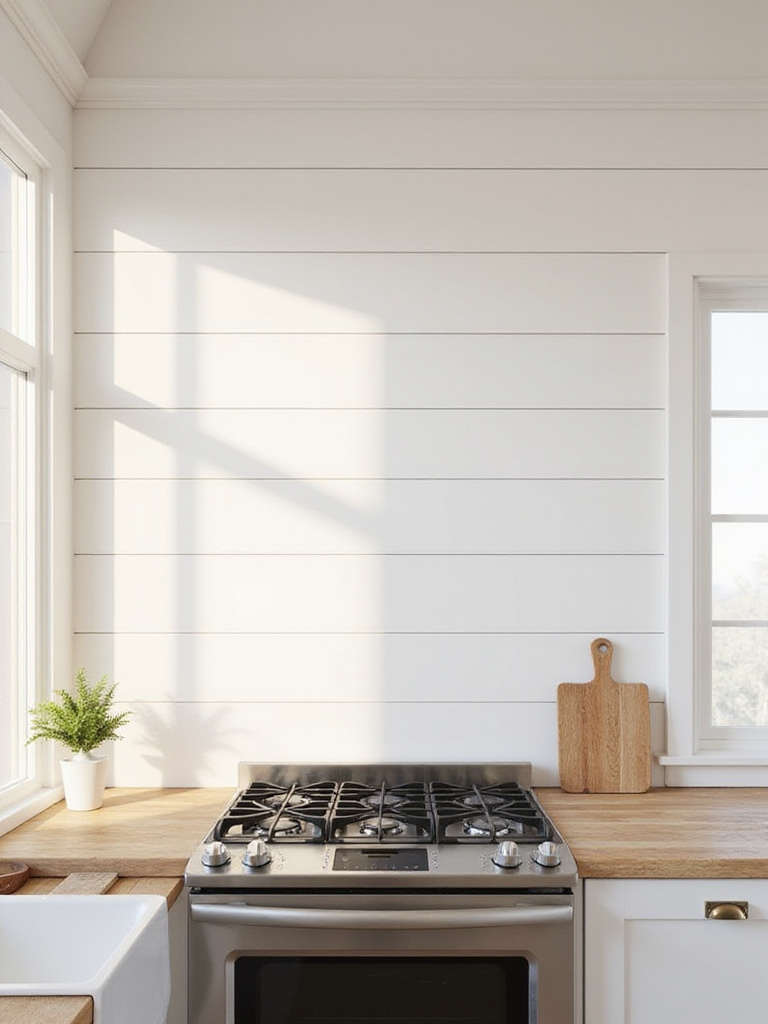
The design process starts with honest assessment of your existing kitchen architecture. Analyze the cabinet construction – are they simple shaker-style panels or more elaborate raised designs? Consider your countertop material’s inherent character – does it suggest the refined simplicity of honed marble or the robust functionality of butcher block? These elements provide the design framework that your backsplash must either complement or thoughtfully contrast.
The craftsmanship reveals itself in details like the relationship between your chosen sub-style and the materials that authentically represent it. Modern Farmhouse might call for large-format subway tiles with minimal grout lines, creating clean geometric patterns that feel both contemporary and timeless. Rustic Farmhouse, conversely, might demand the irregular texture of handmade tiles or the honest imperfection of reclaimed materials.
2. Embrace the Classic: White Subway Tile as Your Design Anchor
White subway tile functions as the architectural equivalent of a perfectly engineered structural element – simple, strong, and endlessly adaptable. In farmhouse design, its geometric precision provides the clean backdrop that allows other materials to express their character. The 3×6 format creates a human-scaled pattern that feels both substantial and refined, while the beveled edges catch light in ways that add subtle dimensional interest.
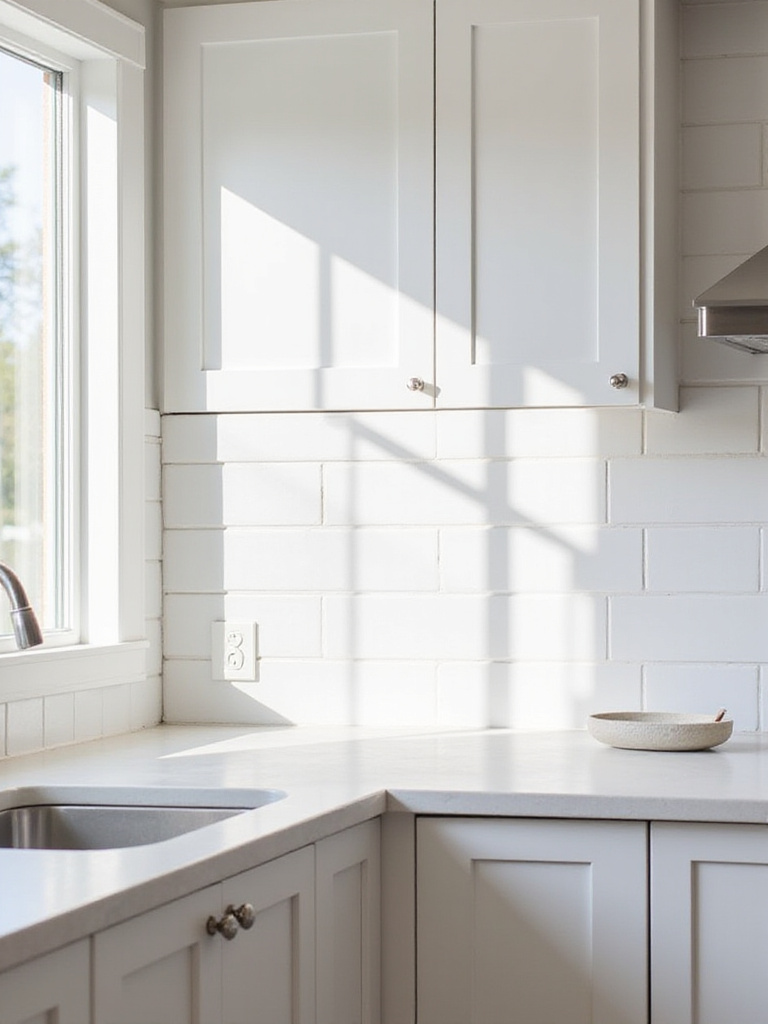
The installation approach significantly impacts the final aesthetic. Traditional offset installation creates the familiar brick-lay pattern that suggests craftsmanship and intentionality. However, consider the visual weight of straight-stack installation for a more contemporary interpretation, or explore the dynamic movement of herringbone for spaces that can handle increased visual complexity. The grout color becomes your design tool – white grout creates seamless continuity, while charcoal grout emphasizes each tile’s individual geometry.
What makes this design special is the way white subway tile anchors more complex material combinations. It provides visual rest between areas of intense texture or pattern, functioning like the negative space in architectural composition. The material’s inherent durability and ease of maintenance align perfectly with the farmhouse principle of beautiful functionality.
3. Channel Authentic Character with Shiplap Installation
Shiplap brings the honest construction methods of agricultural buildings directly into the contemporary kitchen. The horizontal lines create visual width while the material’s inherent texture adds the kind of authentic character that mass-produced tiles simply cannot replicate. When properly sealed for kitchen use, shiplap offers a surprisingly practical alternative to traditional tile, eliminating grout lines that can harbor bacteria and stains.
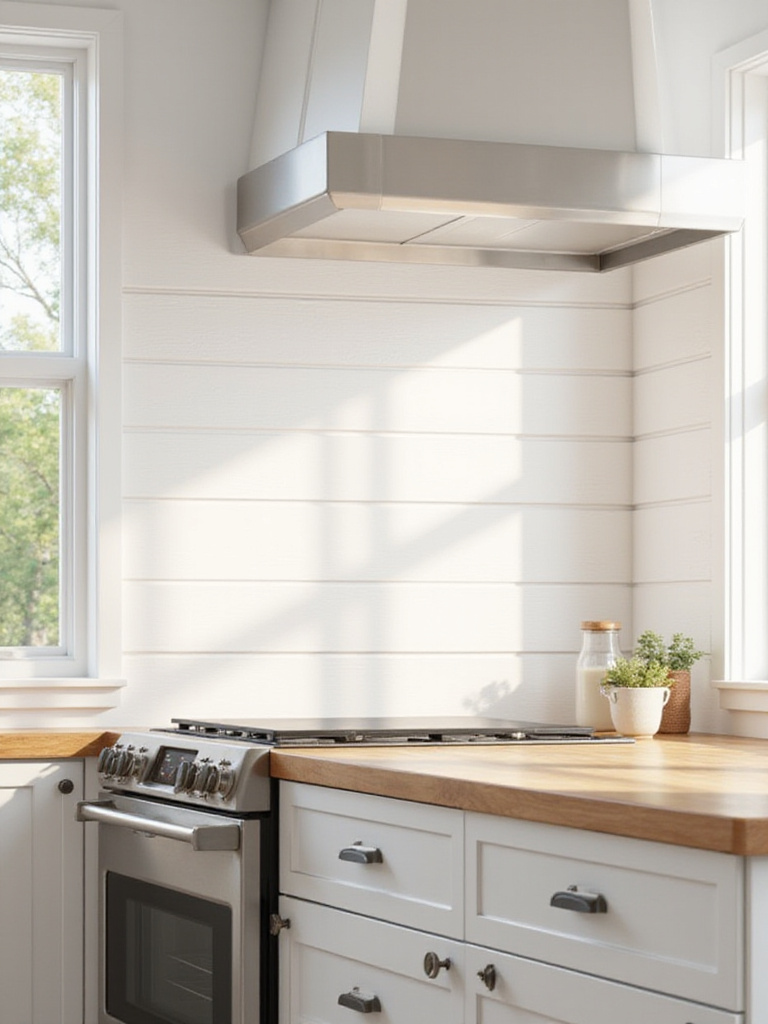
The installation requires attention to both aesthetic and functional details. Proper moisture barriers and high-quality paint systems are non-negotiable in kitchen applications. Consider using marine-grade sealers beneath paint systems designed for high-humidity environments. The horizontal orientation naturally draws the eye along the wall plane, making kitchens feel wider and more expansive – a principle I frequently employ in narrow urban spaces.
The visual weight balances perfectly when you treat shiplap as a backdrop material rather than a focal point. Paint it in colors that complement your cabinetry – soft whites for brightness, or deeper tones that create sophisticated contrast. The key lies in understanding that shiplap’s value comes from its texture and craftsmanship story, not from bold color statements.
4. Build Character Through Exposed Brick Applications
Brick introduces the kind of material honesty that defines both industrial and farmhouse aesthetics. The inherent color variation and textural irregularity create visual depth that transforms flat wall surfaces into compelling focal points. Unlike painted surfaces, brick develops character over time, aging gracefully while maintaining its structural integrity and protective function.
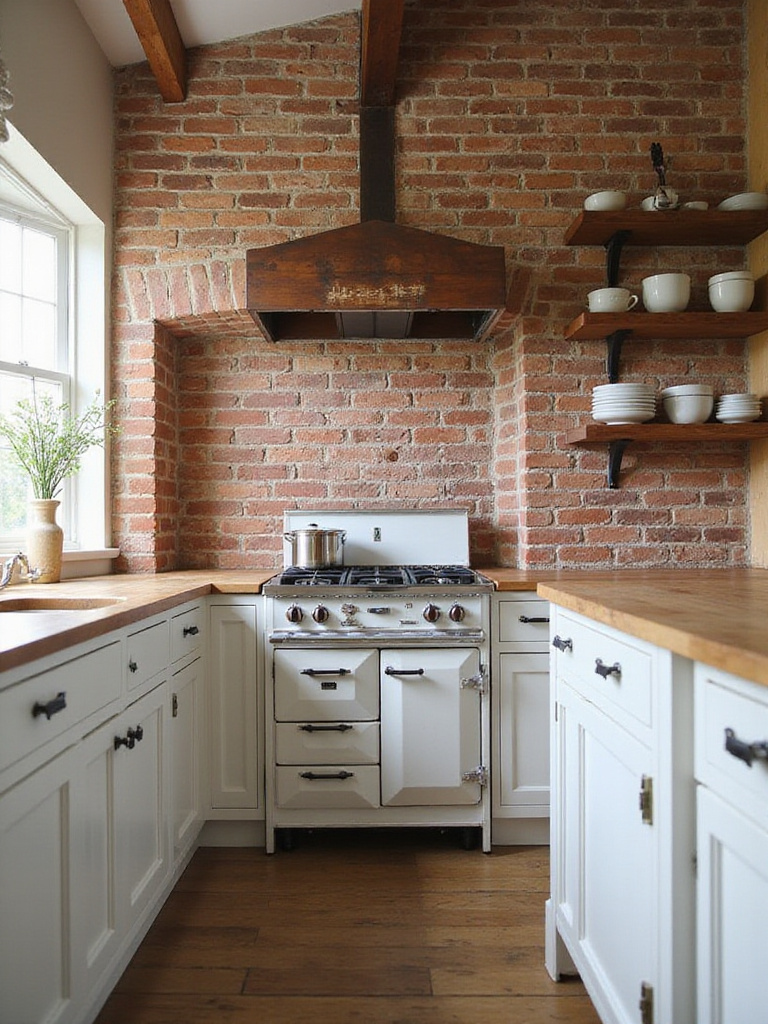
The technical execution demands careful attention to sealing and maintenance systems. Brick’s porosity requires proper treatment to prevent grease absorption and staining. Consider penetrating sealers that protect without altering the material’s natural appearance, followed by periodic maintenance to ensure long-term performance. The grout selection dramatically impacts the final aesthetic – wide mortar joints emphasize the rustic character, while tight joints create a more refined appearance.
The composition comes together when you balance brick’s visual weight against other kitchen elements. Light-colored cabinetry provides contrast that prevents the space from feeling heavy, while strategic lighting emphasizes the material’s texture and depth. Consider using brick selectively – perhaps behind the range or as an accent wall – rather than overwhelming the entire space.
5. Create Architectural Interest with Beadboard Panels
Beadboard’s vertical groove pattern introduces architectural detail that references traditional farmhouse construction methods. The material’s linear rhythm creates visual texture without overwhelming smaller spaces, while its paintable surface offers infinite customization possibilities. This approach provides significant cost advantages over tile installation while delivering authentic period character.
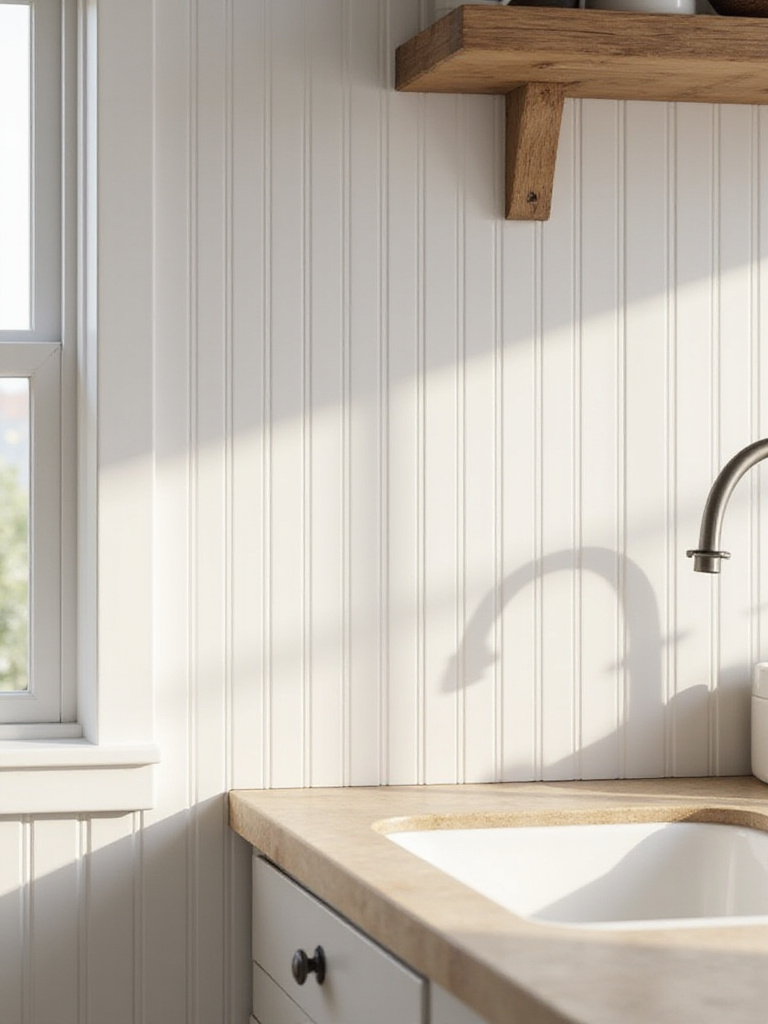
The installation process requires attention to moisture management and proper finishing techniques. Marine-grade MDF or solid wood options provide superior durability in kitchen environments. The paint system becomes critical – use high-quality primer and finish coats designed for kitchen applications, with semi-gloss or satin sheens that resist moisture and allow easy cleaning. Proper caulking at all joints prevents water infiltration and maintains a professional appearance.
The styling mistake most people make is treating beadboard as purely decorative rather than architectural. Install it with the same precision you’d apply to any permanent architectural element, ensuring plumb installation and consistent reveal patterns. The material works exceptionally well in cottage-style farmhouse kitchens where its traditional character feels authentic rather than applied.
6. Introduce History Through Reclaimed Wood Applications
Reclaimed wood brings unparalleled authenticity to farmhouse kitchen design, each board carrying the patina and character marks of its previous life. The material’s inherent imperfections – nail holes, weathering patterns, color variations – create visual interest that manufactured materials cannot replicate. When properly treated for kitchen use, reclaimed wood offers both environmental benefits and unique aesthetic appeal.
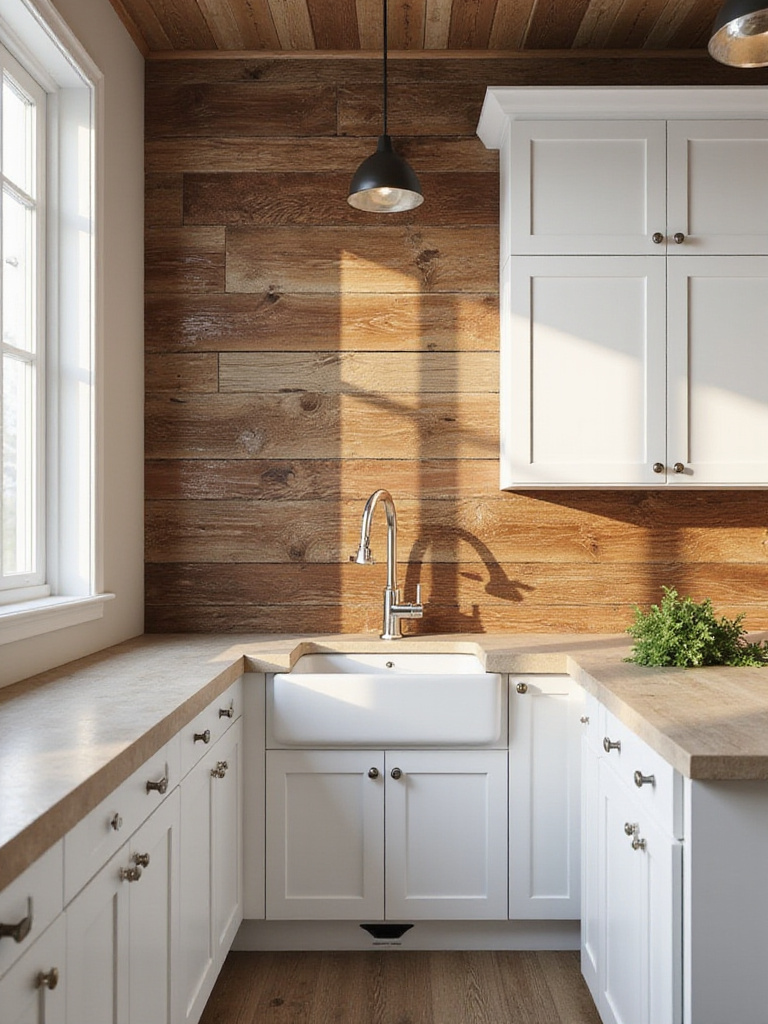
The technical challenges require professional attention to moisture protection and fire safety considerations. Multiple coats of marine-grade sealers protect against kitchen humidity and grease, while local building codes may dictate specific treatments for areas near cooking surfaces. Source materials from reputable suppliers who can verify the wood’s history and ensure proper preparation for interior use.
The unexpected pairing that always works is reclaimed wood with contemporary hardware and fixtures. The contrast between aged wood character and clean modern elements creates visual tension that elevates both materials. Consider using reclaimed wood selectively – perhaps behind a range or sink area – where its character can be appreciated without overwhelming the space’s overall composition.
7. Explore Dynamic Patterns Beyond Basic Layouts
The geometric possibilities within farmhouse design extend far beyond simple running bond patterns. Herringbone installation creates dynamic movement that draws the eye while maintaining the clean lines essential to farmhouse aesthetics. Large-format hexagonal tiles introduce organic geometry that softens the rigid linearity of traditional farmhouse elements without abandoning the style’s fundamental character.

Pattern selection must consider the scale relationship between tile size and room dimensions. Small spaces benefit from larger, simpler patterns that don’t compete for visual attention, while expansive kitchens can accommodate more complex geometric arrangements. The grout color becomes crucial in pattern-heavy installations – matching grout minimizes visual chaos, while contrasting grout emphasizes the geometric structure.
The visual weight balances perfectly when you limit complex patterns to specific zones rather than entire walls. Consider using herringbone behind the range as a focal point while maintaining simpler patterns elsewhere. This approach creates hierarchy and prevents pattern overload while still introducing the sophisticated detail that elevates farmhouse design beyond basic rustic styling.
8. Define Character Through Strategic Grout Selection
Grout color functions as the framework that either emphasizes or minimizes tile geometry, fundamentally altering the backsplash’s visual impact. Dark grout against light tile creates bold geometric emphasis that adds graphic strength to simple patterns. Light grout maintains visual continuity that allows tile texture and color variation to dominate the composition.
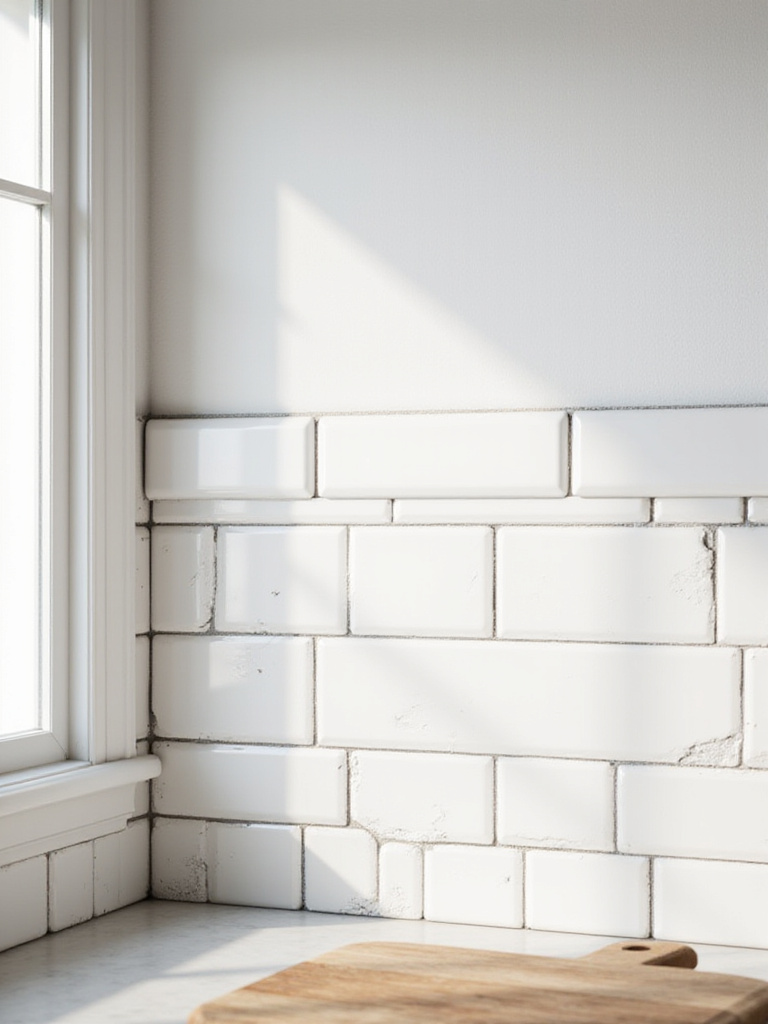
The technical performance of grout selection extends beyond aesthetics to maintenance and durability considerations. Darker grout colors hide everyday stains and wear patterns better than light colors, reducing maintenance requirements over time. Epoxy-based grouts offer superior stain resistance and durability compared to traditional cement-based options, particularly important in high-use kitchen environments.
The professional stylists approach this by first considering the room’s overall contrast levels. High-contrast grout works well in kitchens with strong architectural elements and bold material choices. Subtle grout colors suit spaces where multiple materials and textures create complexity that doesn’t need additional graphic emphasis from grout lines.
9. Establish Proper Scale Through Height Planning
Backsplash height determines both functional protection and visual proportion within the kitchen composition. Standard 18-inch heights work well under upper cabinets but may feel truncated in areas with open shelving or windows. Full-height installations create dramatic impact while providing maximum protection, particularly valuable behind cooking surfaces where splatter protection is critical.

The architectural rhythm emerges when backsplash heights align with existing horizontal elements like window sills, cabinet lines, or ceiling details. Arbitrary stopping points create visual awkwardness that undermines the design’s overall coherence. Consider extending backsplashes to natural break points that feel intentional and finished rather than budget-driven.
The challenge of awkward spaces becomes easier when you treat height variations as opportunities for visual interest rather than problems to solve. Different heights in different zones can create functional hierarchy – full height behind the range for maximum protection, standard height under cabinets for cost efficiency, and custom heights around windows for architectural integration.
10. Calculate Investment Requirements Accurately
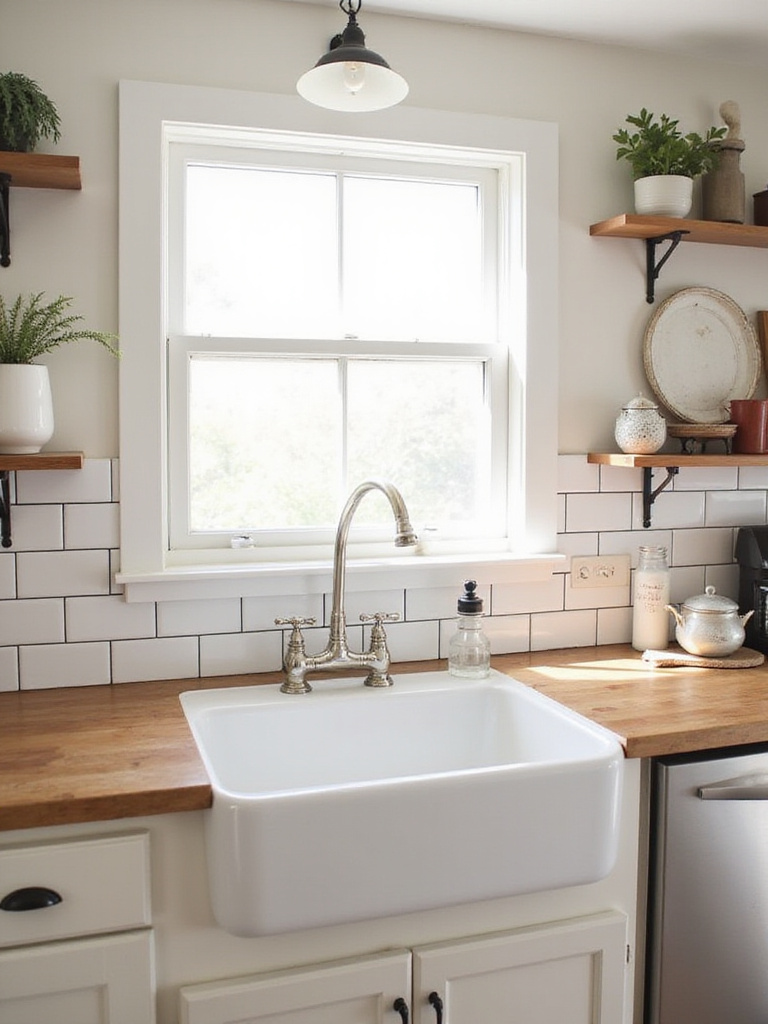
Farmhouse kitchen backsplash project costs vary dramatically based on material selection and installation complexity. Basic ceramic subway tile installations might cost $15-25 per square foot including labor, while natural stone or complex patterns can reach $40-60 per square foot. Understanding these ranges helps establish realistic budgets and prevents costly mid-project changes.
Labor costs typically represent 60-70% of professional installation expenses, making DIY consideration financially attractive for straightforward patterns. However, complex materials like natural stone or irregular tiles require professional expertise to achieve acceptable results. Factor in tool rental, material waste, and potential mistake correction when comparing DIY versus professional installation costs.
The investment value comes from the exceptional durability and visual impact that quality backsplash installation provides. Unlike paint or decorative accessories, a well-executed backsplash adds permanent value while serving essential protective functions. Consider cost per year over expected lifespan rather than just initial installation expense when evaluating material options.
11. Assess DIY Installation Capabilities Honestly
DIY backsplash installation can deliver significant cost savings for homeowners with basic construction skills and appropriate tools. Simple patterns like running bond subway tile require primarily measuring, cutting, and adhesive application skills that motivated beginners can master. However, complex patterns, irregular tiles, or challenging room layouts demand professional expertise to achieve acceptable results.
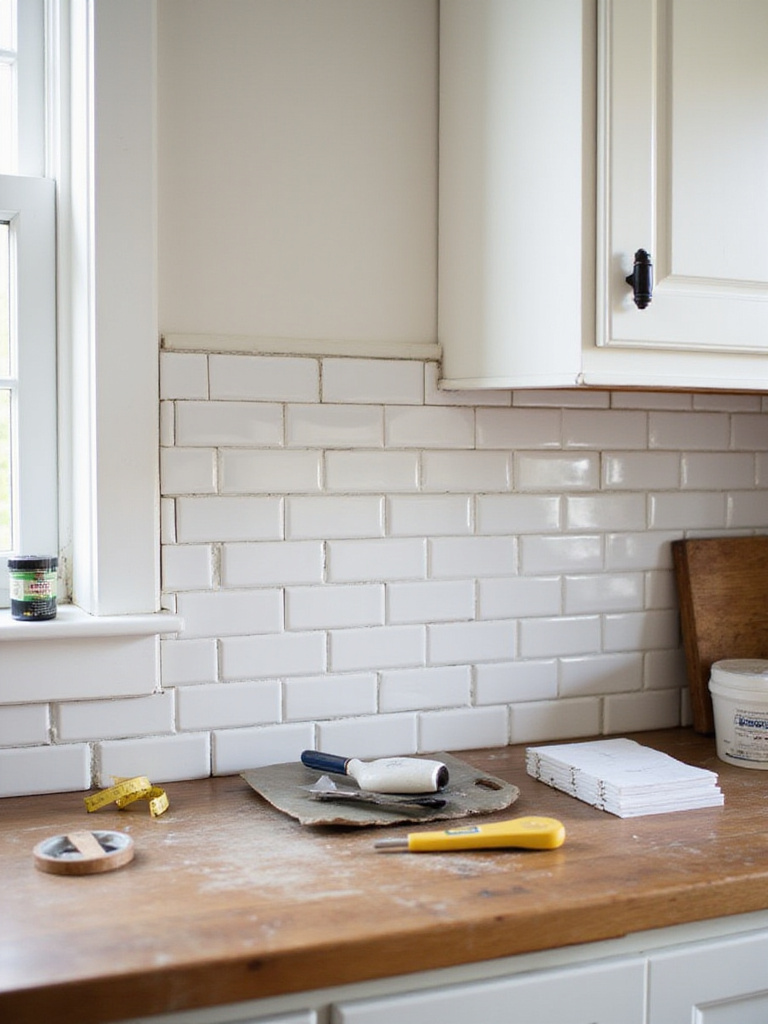
The time commitment extends beyond actual installation to include surface preparation, material procurement, and finishing work. Plan for 2-3 times longer than professional installation, particularly for first-time DIY projects. Factor in tool rental costs, material waste from learning curves, and potential correction expenses when comparing DIY versus professional installation costs.
The construction technique that ensures longevity involves proper surface preparation, adhesive application, and grout installation. Skipping preparation steps or using incorrect materials can lead to failure that costs more to correct than professional installation would have cost initially. Honest self-assessment of skill level and available time prevents costly mistakes and frustration.
12. Maintain Surface Integrity Through Proper Care
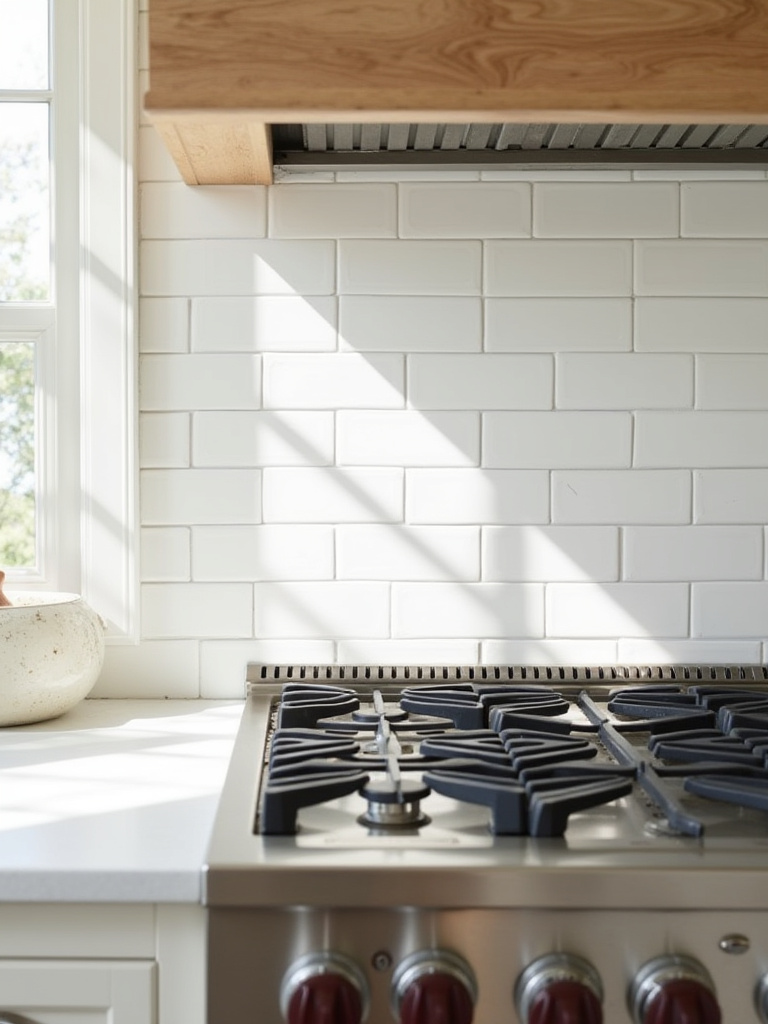
Consistent maintenance preserves both the aesthetic appeal and functional performance of farmhouse kitchen backsplash installations. Daily cleaning with appropriate pH-neutral cleaners prevents grease buildup and staining that can permanently damage porous materials. Immediate attention to spills, particularly acidic substances, prevents etching and discoloration that becomes increasingly difficult to correct over time.
The material sourcing makes all the difference in how maintenance requirements vary between different backsplash options. Sealed natural stone requires different care than glazed ceramic tile, while painted wood surfaces need different attention than sealed grout lines. Understanding these requirements before installation helps establish realistic maintenance expectations and prevents damage from inappropriate cleaning methods.
The quality becomes evident after years of use when properly maintained backsplashes retain their original appearance while neglected installations show wear, staining, and deterioration. Establish cleaning routines that match your lifestyle and material choices. Regular maintenance requires less time and effort than periodic deep cleaning or eventual replacement due to neglect.
13. Coordinate Seamlessly with White Cabinet Systems
White farmhouse cabinets provide the neutral foundation that allows backsplash materials to express their full character without color competition. This combination creates the bright, clean aesthetic that defines contemporary farmhouse style while offering flexibility for seasonal decoration and evolving personal taste. The key lies in selecting backsplash materials that add texture and interest without overwhelming the space’s fundamental simplicity.
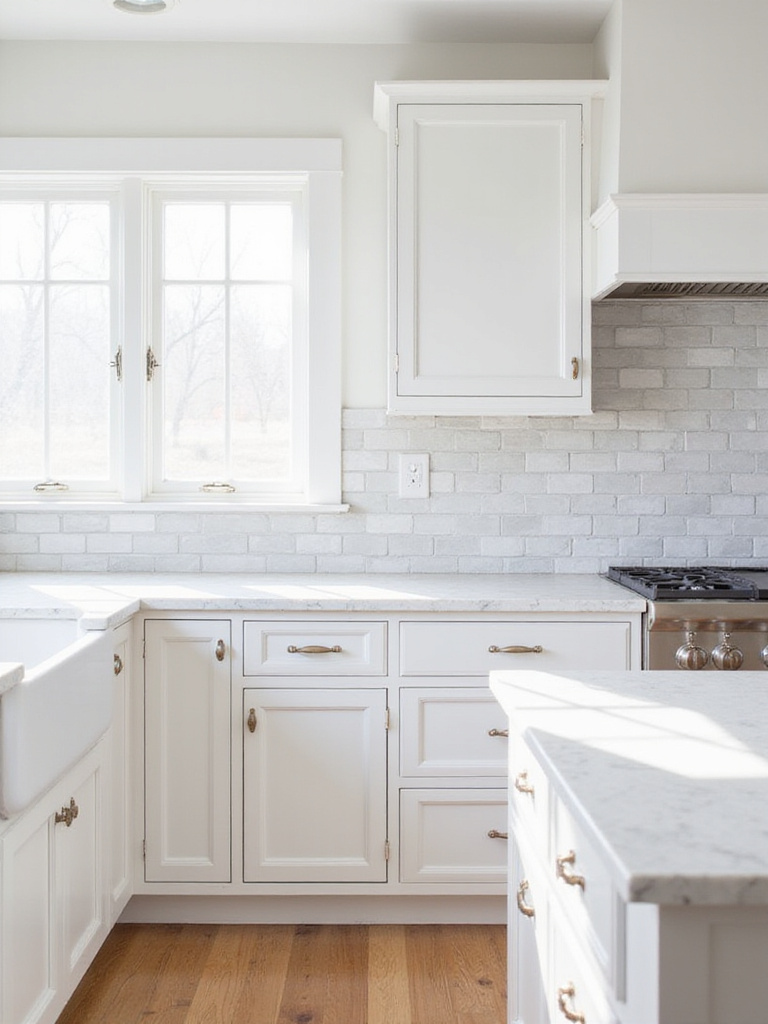
The design language speaks to balance between the smooth surfaces of painted cabinets and the textural interest of backsplash materials. Subway tile with beveled edges adds subtle dimension, while natural stone introduces organic variation that prevents sterile uniformity. Consider how different lighting conditions affect the interaction between white cabinets and backsplash materials throughout the day.
The finishing touch that elevates the entire look involves careful attention to grout color and cabinet hardware coordination. Darker grout adds definition and prevents the backsplash from disappearing against white cabinets, while hardware finishes should complement rather than exactly match backsplash materials. This approach creates sophisticated layering rather than monotonous matching.
14. Balance Dark Cabinet Compositions Thoughtfully
Dark farmhouse cabinets create dramatic sophistication but require careful backsplash selection to prevent overwhelming the space. Light-colored backsplashes provide essential contrast that maintains visual balance while reflecting available light to brighten the overall composition. The relationship between dark cabinets and backsplash materials fundamentally affects the kitchen’s perceived size and character.
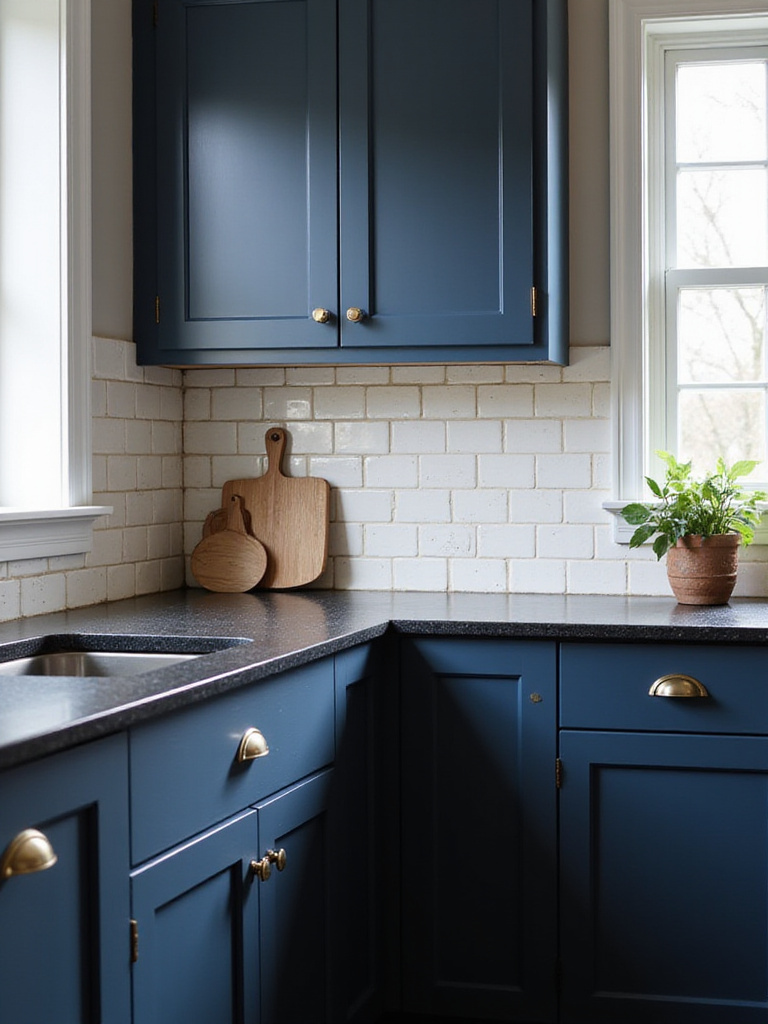
The environmental story behind this choice involves understanding how natural and artificial lighting interact with dark surfaces. Kitchens with abundant natural light can handle more dramatic contrast, while spaces with limited light benefit from lighter backsplash materials that maximize brightness. Consider how the backsplash will appear during evening hours when artificial lighting dominates.
The artisans’ commitment to environmental practices means selecting backsplash materials that complement rather than compete with dark cabinet investment. White or light-colored tile, natural stone, or painted wood surfaces provide the contrast needed while maintaining the sophisticated character that dark cabinets establish. Strategic use of reflective materials enhances light distribution throughout the space.
15. Create Visual Continuity with Countertop Integration
Seamless transitions between countertop and backsplash materials create the sophisticated coherence that distinguishes professional design from amateur decoration. This approach eliminates visual breaks that can make spaces feel fragmented while establishing material relationships that feel intentional and refined. The technique works particularly well with natural stone materials that can extend from horizontal to vertical surfaces.
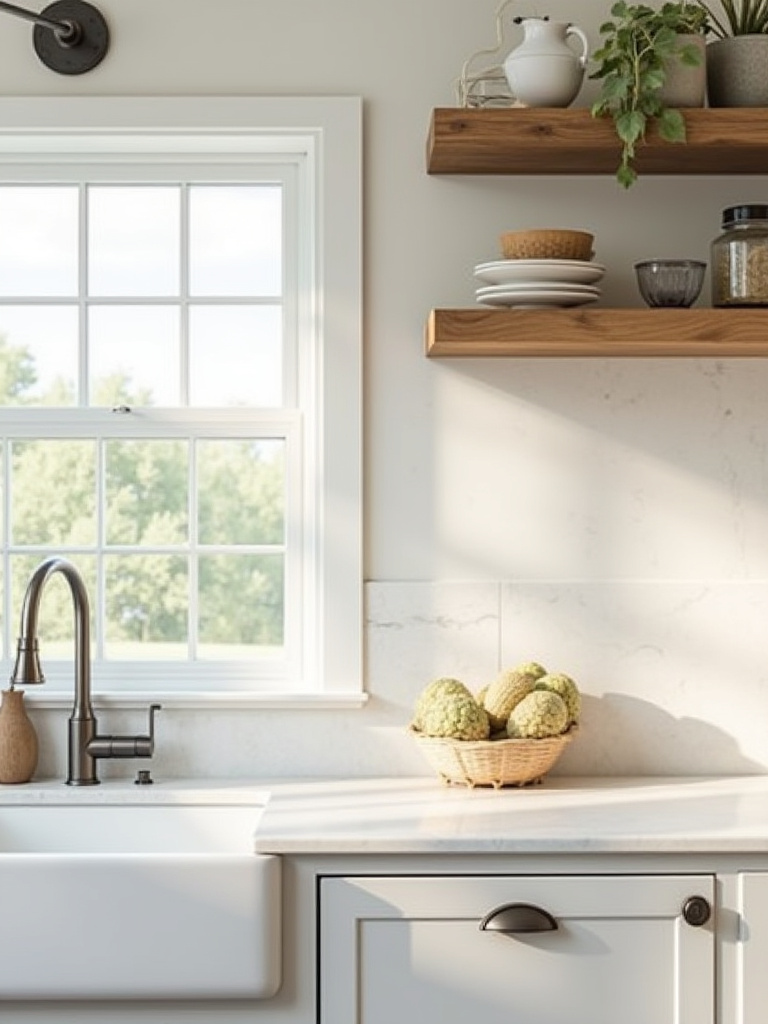
The sustainable journey of this material involves understanding how different fabrication and installation methods affect both cost and visual impact. Slab backsplashes eliminate grout lines entirely, creating smooth surfaces that are easier to clean and maintain. However, this approach requires careful planning for electrical outlets and precise measurement to avoid costly mistakes during fabrication.
The traditional methods used result in installations that feel custom and sophisticated rather than assembled from standard components. Consider extending countertop materials up the wall behind ranges or sinks where visual impact is greatest, while using complementary tile materials in less prominent areas to balance cost and effect.
16. Achieve Quick Updates with Peel-and-Stick Solutions
Peel-and-stick backsplash materials offer immediate transformation for renters or homeowners seeking temporary solutions without permanent installation commitment. Modern adhesive technologies and improved printing techniques create surprisingly convincing replications of traditional materials like subway tile, wood planks, and natural stone. These solutions work particularly well for testing design concepts before committing to permanent installations.
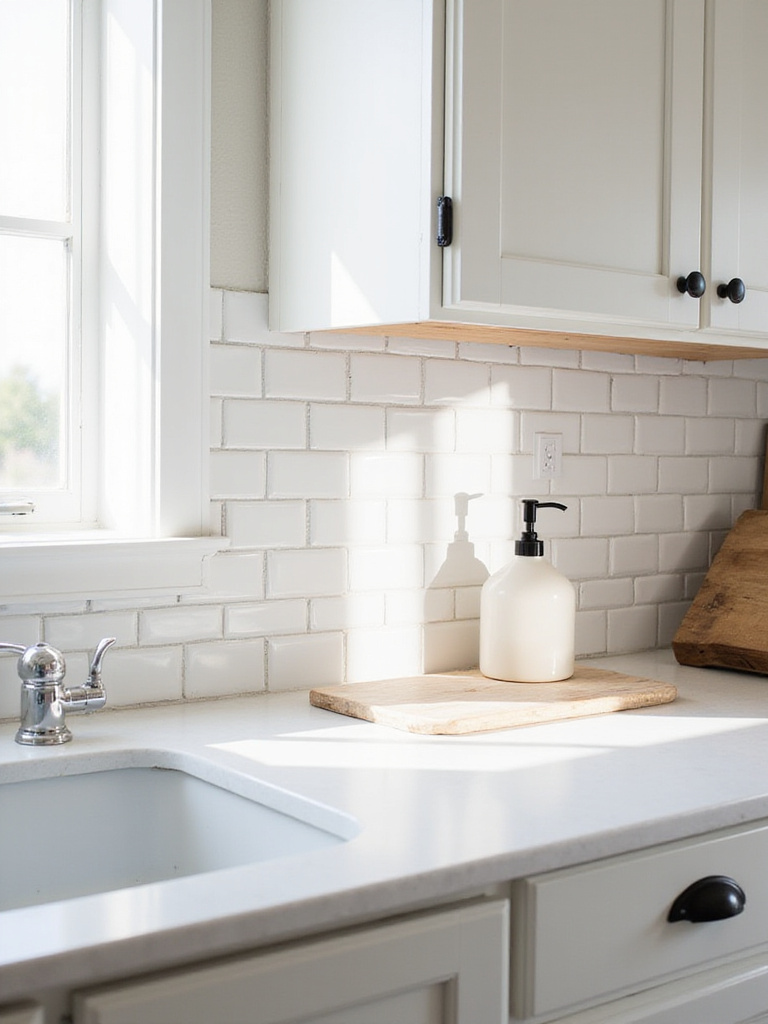
The installation technique that ensures longevity requires proper surface preparation and quality material selection. Clean, smooth surfaces provide optimal adhesion, while textured or damaged walls may require additional preparation. Higher-quality peel-and-stick products offer better adhesion and more convincing appearance than budget alternatives, making material selection crucial for acceptable results.
Beyond aesthetics, the ecological impact matters because peel-and-stick installations generate minimal waste and require no special tools or professional installation. However, consider long-term performance expectations – these materials typically last 2-5 years depending on kitchen conditions and usage patterns. They function best as interim solutions rather than permanent installations.
17. Integrate Architecture with Open Shelving Systems
Open shelving creates opportunities for backsplash materials to function as both protective surface and display backdrop. Extending backsplash materials behind and around open shelves eliminates awkward stopping points while creating visual continuity that makes the wall treatment feel architectural rather than applied. This approach works particularly well with materials like subway tile or painted wood that provide neutral backgrounds for displayed items.
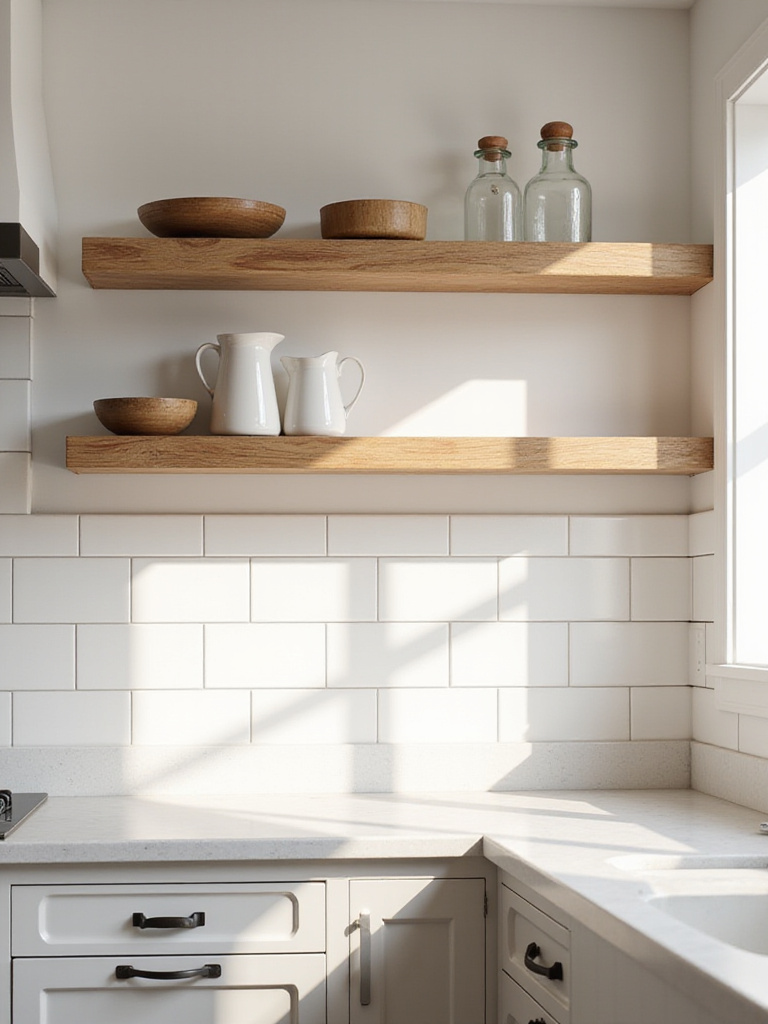
The collaboration began with a conversation about how functional display and protective surfaces can work together. Open shelving exposes wall areas to potential damage from stored items and daily use, making durable backsplash materials essential for long-term performance. Consider how shelf placement interacts with backsplash patterns and how the combination affects cleaning and maintenance access.
The maker’s journey from apprentice to master influenced the understanding that open shelving and backsplash integration requires careful planning of both systems. Install backsplash materials first, then mount shelving over them for the cleanest appearance. This sequence ensures proper waterproofing and allows for easier shelf adjustment or removal in the future.
18. Develop Character Through Textural Materials
Textured tiles and handcrafted materials like Zellige introduce the kind of surface variation that prevents farmhouse kitchens from feeling flat or sterile. These materials catch and reflect light irregularly, creating dynamic shadow patterns that change throughout the day. The inherent imperfections and variations speak to the handcrafted character that defines authentic farmhouse aesthetics.
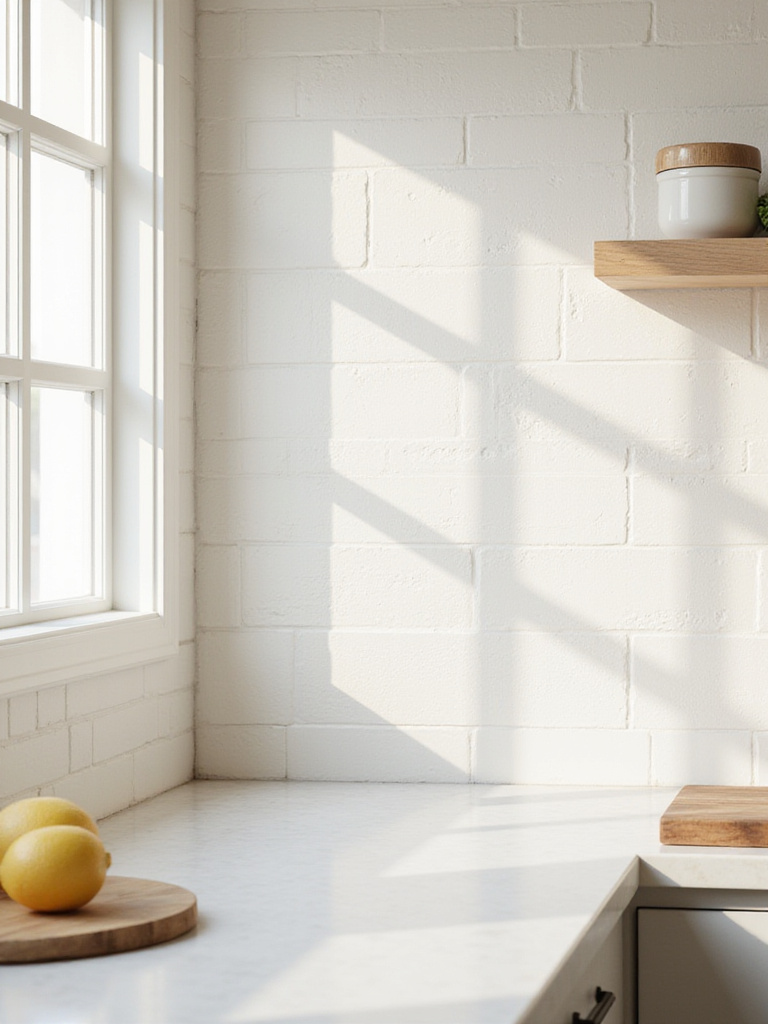
The hand-finishing process creates variations that distinguish artisanal materials from mass-produced alternatives. Zellige tiles, formed by hand and fired in traditional kilns, exhibit color and size variations that create unique installations impossible to replicate with manufactured tiles. This authenticity comes at a premium but delivers character that justifies the investment for discerning homeowners.
19. Navigate Common Design Pitfalls Successfully
Scale mismatches represent the most frequent error in farmhouse kitchen backsplash selection. Small, busy patterns overwhelm compact spaces while tiny tiles disappear in large kitchens. The visual rhythm must complement the room’s proportions and existing architectural elements. Understanding this relationship prevents costly mistakes that require complete reinstallation to correct.

The design problem this product uniquely solves involves balancing authentic farmhouse character with contemporary functionality. Avoid over-theming that makes spaces feel like stage sets rather than functional kitchens. Authentic farmhouse design emerges from practical material choices and honest construction methods, not from accumulating rustic accessories and distressed finishes.
The unexpected environmental benefit comes from choosing durable materials and installation methods that extend service life. Quality materials properly installed last decades rather than years, reducing replacement waste and long-term costs. Consider lifecycle costs and environmental impact when selecting between cheaper alternatives and premium materials that offer superior longevity.
20. Embrace Contemporary Farmhouse Evolution
Current farmhouse backsplash trends emphasize texture and authenticity over purely decorative elements. Handmade-look tiles, including Zellige and crackle-glazed ceramics, satisfy the desire for unique character while maintaining the clean functionality that modern kitchens require. These materials bridge traditional craftsmanship with contemporary performance standards.
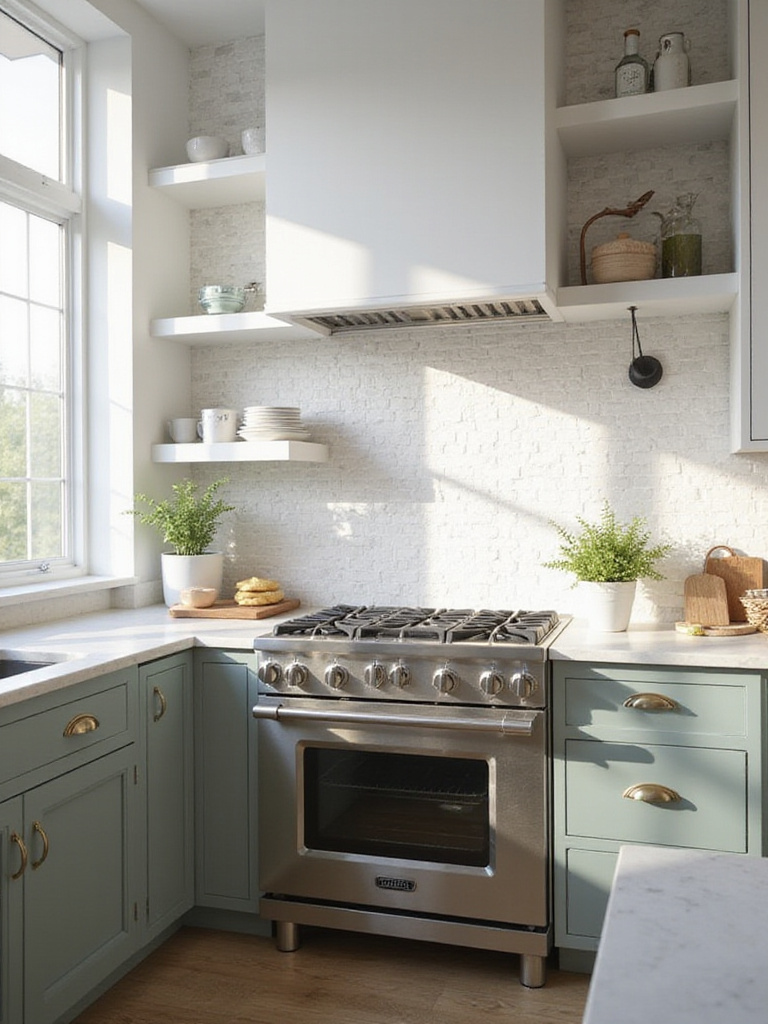
The evolution of this trend reflects broader cultural shifts toward sustainable and locally-sourced materials. Reclaimed wood, recycled glass tiles, and locally-produced ceramics appeal to environmentally conscious homeowners while supporting regional craftspeople. This approach aligns with farmhouse values of community connection and environmental stewardship.
The forecast for next season already hints at continued movement toward mixed materials and varied textures within single installations. Combining different materials – perhaps subway tile with wood accents or stone with metal elements – creates visual interest while maintaining the authentic character that defines farmhouse style. This approach prevents monotony while respecting traditional design principles.
Conclusion
The foundation of exceptional farmhouse kitchen backsplash design lies in understanding that authentic farmhouse style emerges from honest material choices and purposeful functionality rather than decorative themes. Through examining these 20 essential approaches, we’ve explored how different materials – from classic subway tile to reclaimed wood, from exposed brick to handcrafted Zellige – each contribute unique character while serving the practical demands of kitchen environments.
The principles that guide successful farmhouse backsplash selection mirror those I apply in industrial design: respect for materials, attention to scale and proportion, and integration with existing architectural elements. Whether you choose the clean geometry of subway tile, the authentic texture of shiplap, or the artisanal character of handmade ceramics, success depends on understanding how each choice affects the space’s overall composition and daily functionality.
Your farmhouse kitchen backsplash represents more than surface decoration – it’s an investment in both aesthetic appeal and practical performance that will serve your family for years to come. The time invested in careful material selection, proper installation planning, and realistic budget assessment pays dividends in long-term satisfaction and functionality. Move forward with confidence, knowing that thoughtful choices guided by solid design principles will create the authentic farmhouse character you envision.

